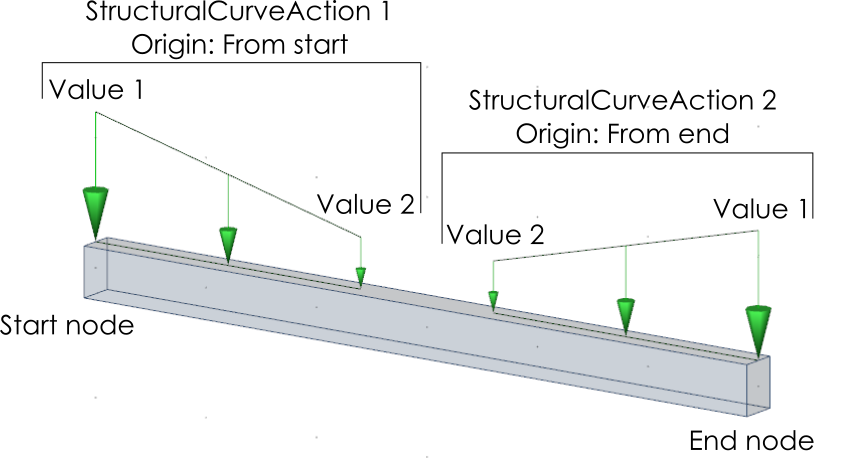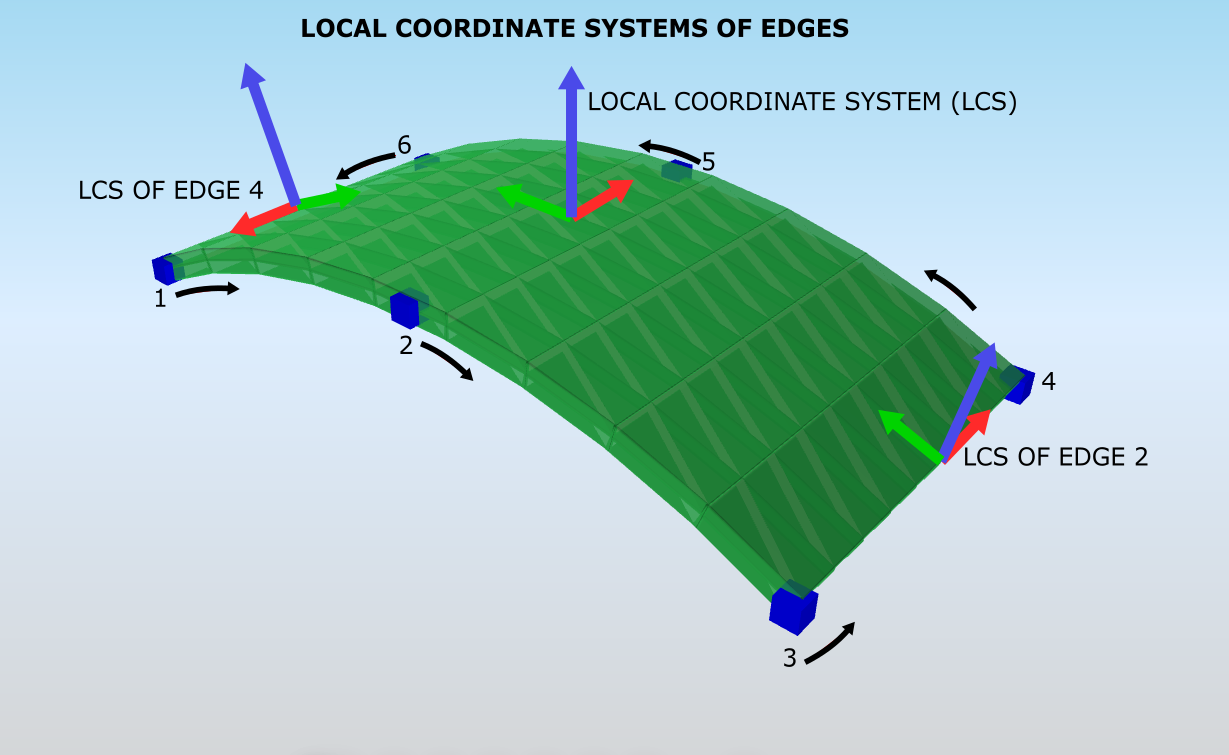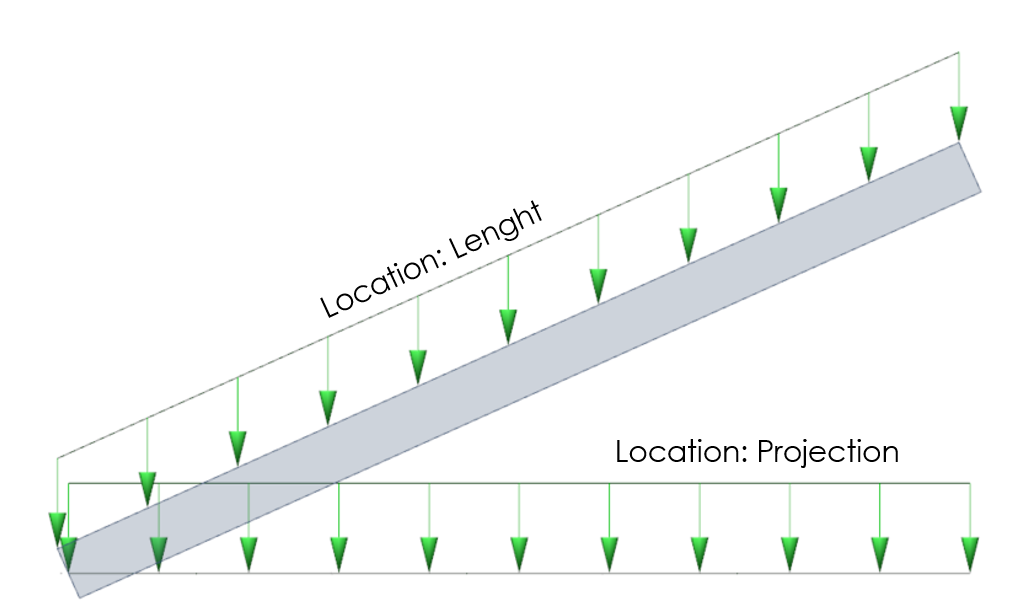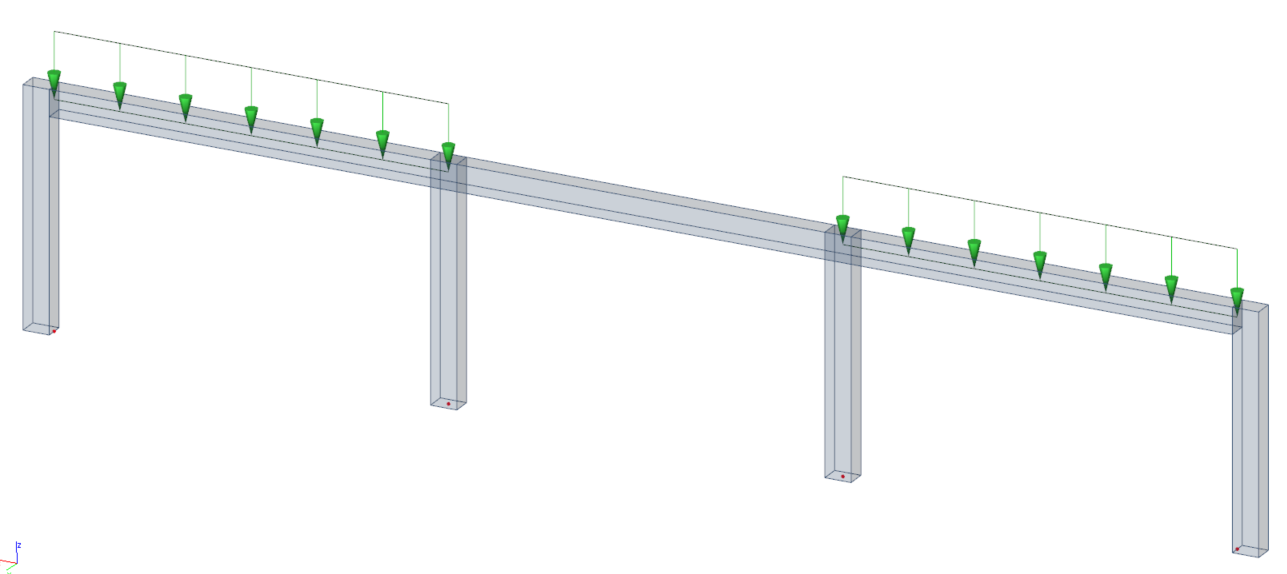StructuralCurveMoment¶
Line Moment on the beam
The Line moment load models load distributed over a 1D member (StructuralCurveMember), 1D member Rib (StructuralCurveMemberRib) or on a slab edge (StructuralSurfaceMember). It may be action along the whole 1D member or only on its part. It can be constant or trapezoidal, acting in three main directions X, Y, Z (global or local coordinate system).
Specification in the excel¶
Column header |
Data type |
Example / enum definition |
Required |
Description |
|---|---|---|---|---|
Name |
String |
LMS1 |
yes |
Human readable unique name of the force |
Type |
String |
Standard |
no |
This property defines what the load is caused by, E.g. Standard, Wind, Snow, Self weight, Hoar Frost, Predefined, Plane Load, Water Pond, Water Pressure, Soil Pressure, Generated Water, Generated Soil |
Force action |
Enum |
On beam On edge On subregion edge On opening edge On rib On internal edge |
yes |
Specifies on which type of object the force acts |
Distribution |
Enum |
Uniform Trapez |
yes |
The line moment may be either constant along the 1D member or linearly variable (trapezoidal). |
Direction |
Enum |
Mx My Mz |
yes |
Specifies the base direction of the load |
Value 1 [kNm/m] |
Double |
-150 |
yes |
Specifies the first size of the moment in kilonewton meters per meter Value1 is always closer to origin (see notes) |
Value 2 [kNm/m] |
Double |
-180 |
yes, if Distribution = Trapez |
Specifies the second size of the load in kilonewton meters per meter Value1 is always further from origin (see notes) |
Member |
String |
B11 |
yes, if Force action = On beam |
The name of the StructuralCurveMember on which the load is applied |
Member Rib |
String |
B11 |
yes, if Force action = On rib |
The name of the StructuralCurveMemberRib on which the load is applied |
2D Member |
String |
S1 |
yes, if Force action = On edge or On internal edge |
The name of the StructuralSurfaceMember on which the load is applied or to which the internal edge belongs |
2D Member Region |
String |
R1 |
yes, if Force action = On subregion edge |
The name of the StructuralSurfaceMemberRegion on which is the load applied. |
2D Member Opening |
String |
O1 |
yes, if Force action = On opening edge |
The name of the StructuralSurfaceMemberOpening on which is the load applied. |
Edge |
Integer |
1 |
yes, if Force action = On edge, On opening edge or On subregion edge |
The index starting with 1. The order is according to order of “edges” property at StructuralSurfaceMember, StructuralSurfaceMemberOpening or StructuralSurfaceMemberRegion on which the load is applied |
Internal edge |
String |
ES2 |
yes, if Force action = On internal edge |
The name of the StructuralCurveEdge on which the load is applied. |
Load case |
String |
LC1 |
yes |
The name of the load case to which the force belongs |
Coordinate system |
Enum |
Global Local |
yes |
Defines the coordinate system in which the load is defined. For ‘Local’: the coordinate system is defined by the member on which the load is applied. See Notes for more. |
Location |
Enum |
Length Projection |
yes |
Specifies whether the load is “put directly on an inclined 1D member” or whether the “projection on plan” is defined. For the ‘Local’ coordinate system, the only applicable option is ‘Length’. For the ‘Global’ coordinate system choose between ‘Length’ and ‘Projection’. |
Coordinate definition |
Enum |
Absolute Relative |
yes |
Selects the coordinate system that is used to define the length of the line load. Relative means without units. To define length of the load in meters input absolute |
Origin |
Enum |
From start From end |
yes |
Specifies the origin of the coordinate system used for the definition of the length of the force |
Extent |
Enum |
Full Span |
yes |
Defines if a load is extended just over a span instead of the whole 1D member, it is used if a 1D member consists of more than one span. This feature is not fully supported, only two spans are supported in the moment. |
Start point [m] |
Double |
value in meters for Coordinate definition = Absolute 0.0 value in percentage for Coordinate definition = Relative 0.0 |
yes |
Defines the position of the start point of the moment in relative or absolute coordinates [m] |
End point [m] |
Double |
value in meters for Coordinate definition = Absolute 5.25 value in percentage for Coordinate definition = Relative 1.0 |
yes |
Defines the position of the end point of the moment in relative or absolute coordinates [m] |
Parent ID |
String |
67b35d84-3d04-47aa-aa4a-dc1263982320 |
no |
Is filled for objects created be dividing curved geometry to series of straight line objects. To ensure successful round trip of segmented objects and their related objects, Parent ID needs to be present in both directions. |
Id |
String |
39f238a5-01d0-45cf-a2eb-958170fd4f39 |
no |
Unique attribute designation |
Notes¶
An example with Distribution type Trapez and with different values 1 and 2 can be seen in the following picture. Coordinate definition is relative, start point 0 and end point 0,3. StructuralCurveAction 1 has origin “From start” and StructuralCurveAction 2 has origin “From end”. In this case the parameter extent doesn’t make any difference, only in case of beams consisting of more parts.

For ‘Local’ coordinate system (LCS) the load is defined in the LCS of the member it is assigned to. For force action ‘On beam’ and ‘On rib’ it is the LCS of StructuralCurveMember and StructuralCurveMemberRib, respectively. For edges of 2D members the local coordinate system of an edge is used and it is created accordingly:
X-axis is in the direction of the line/curve of the edge. The direction is specified by the order of nodes in the StructuralSurfaceMember
Z-axis is parallel to the local Z-axis of the 2D member. For curved members local Z-axis is always perpendicular to the surface
Y-axis is tangential to the 2D member (it is in its plane) and the direction is set by the right-hand rule


